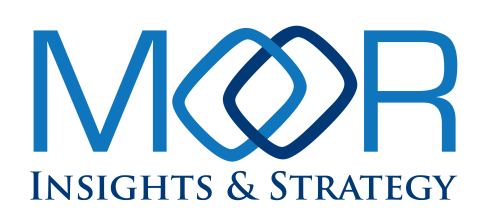
Welcome to this edition of our analyst insights roundup, collecting some of the key insights our analysts have developed based on the past week’s news.

This is a quantum computer chip from Quantinuum, one of Microsoft’s partners in its Azure Quantum project. This collaborative effort brings together quantum, AI, and high-performance computing to accelerate breakthroughs in quantum computing as well as other areas such as chemistry and materials science. Our own Paul Smith-Goodson has been covering this area for years, from household names such as Microsoft and IBM to startups like Quantinuum and Atom Computing.
As usual, our team is busy this week! Robert is in Los Angeles at Teradata. Melody is attending SAP’s TechEd event virtually and will be in San Jose for Zoomtopia. Bill is in Austin for Embedded World NA. Will is attending the MWC Americas and serving as a judge for the T-Mobile for Business Unconventional Awards event in Las Vegas. Patrick and Matt are attending AMD’s Advancing AI Event in San Francisco, and Jason and Robert will be at the AWS GenAI Summit in Seattle.
Last week, Robert attended the Infor Annual Summit in Las Vegas and LogicMonitor’s event in Austin. Melody was at the Cadence Fem.AI Summit in Menlo Park, California, and Microsoft’s Industry Analyst Event in Burlington, Massachusetts.
Next week, Melody will be at AdobeMAX in Miami. Matt, Paul, and Anshel will be attending Lenovo’s Global Analyst Summit & Tech World in Bellevue, Washington. Will is headed to New York for Blackberry’s Analyst Day, while Matt, Robert, and Jason will be in NYC for IBM’s Analyst Summit. Stay tuned for updates from these events!
Our MI&S team published 24 deliverables:
- 6 Forbes Articles
- 1 Research Paper
- 5 MI&S Blog Posts
- 12 Podcasts
Over the last week, our analysts have been quoted multiple times in top-tier international publications with our thoughts on Accenture, Nvidia, China’s AI breakthrough, Meta, Microsoft, Pure Storage, Vast, and the WordPress and WP Engine lawsuit.
MI&S Quick Insights
Last week I got to spend some time with John Capobianco from Selector AI. Selector is a company that is developing a number of AI-based network monitoring and management tools. In particular the Selector team has been creating AI agents and embeddings. Notably, they can show you how a network ops person can use conversational AI to fix network problems from Slack. I was very impressed since what’s being done is very job-contextual and easy to understand. If you are managing networks, you should check it out. But if you don’t manage networks and want to see how someone builds and hacks on agents, you really need to see Capobianco’s YouTube Channel. What’s great is that the videos do a better job of showing how agents actually work than the more polished vendor versions you might see at a show or a demo pod.
Also last week I published a piece on CodeSignal and its developer benchmark. One of the items that stuck out to me was how OpenAI’s new Strawberry model has similar performance across the larger and mini sizes. It was an outlier versus the competition, for which smaller models did not perform as well. After digging into Strawberry a bit, I learned that the model is being positioned as a deeper reasoning model. This does mean it’s moving slower at times, but it’s also “thinking” more. The underlying action driving the reasoning is that the model is performing a chain of thought prompts upon itself as it performs a task. So the model is prompting itself to look for other answers. It’s an interesting departure from what we all have been seeing in the model space. Model size used to be a determining factor in response accuracy—but if the model can reason with itself, what will be the response speed? This is something to keep an eye on, because smaller models are gaining momentum thanks to their lower costs.
Last week I got to spend some time with John Capobianco from Selector AI. Selector is a company that is developing a number of AI-based network monitoring and management tools. In particular the Selector team has been creating AI agents and embeddings. Notably, they can show you how a network ops person can use conversational AI to fix network problems from Slack. I was very impressed since what’s being done is very job-contextual and easy to understand. If you are managing networks, you should check it out. But if you don’t manage networks and want to see how someone builds and hacks on agents, you really need to see Capobianco’s YouTube Channel. What’s great is that the videos do a better job of showing how agents actually work than the more polished vendor versions you might see at a show or a demo pod.
Also last week I published a piece on CodeSignal and its developer benchmark. One of the items that stuck out to me was how OpenAI’s new Strawberry model has similar performance across the larger and mini sizes. It was an outlier versus the competition, for which smaller models did not perform as well. After digging into Strawberry a bit, I learned that the model is being positioned as a deeper reasoning model. This does mean it’s moving slower at times, but it’s also “thinking” more. The underlying action driving the reasoning is that the model is performing a chain of thought prompts upon itself as it performs a task. So the model is prompting itself to look for other answers. It’s an interesting departure from what we all have been seeing in the model space. Model size used to be a determining factor in response accuracy—but if the model can reason with itself, what will be the response speed? This is something to keep an eye on, because smaller models are gaining momentum thanks to their lower costs.
A recent study is centered on an AI model called Future You, which may reduce anxiety by helping people feel better about how they might look and talk at a future age. A chatbot allows subjects to have realistic conversations with a future version of themselves. Researchers concluded that when test subjects interacted with a Future You version of themselves, it reduced their anxiety about getting older.
While there are positive aspects of the Future You, the researchers also have some cautions:
- It is possible that the AI Future You won’t represent the real person and may alter the real, present-day person’s behavior.
- Some personalities may become overly dependent on AI for decision-making, causing them to ignore their own judgment and intuition.
The scientists believe further research is needed to study the possibility of these negative issues and ensure the promotion of ethical AI development.
Many readers here will know that OpenAI’s long-range goal is to develop AGI. Although it has already made amazing progress with ChatGPT, the company continues to create models with more capabilities, such as its recent preview o1 model with benchmarked increased reasoning. Developing even larger models with increased capabilities requires huge amounts of funding. Toward that end, OpenAI just secured a staggering $6.6 billion in funding, which puts the company’s valuation at around $157 billion. Look for OpenAI to build more powerful models over the next 12 to 18 months. In addition, that staggering amount of funding will no doubt set the stage for more AI companies to bring in extraordinary funding rounds of their own.
Waymo is adding the Hyundai Ioniq 5 to its fleet of self-driving vehicles. This means that Waymo is seeing continuing demand and also likely wants a more modern EV platform to work with in the form of Hyundai/Kia’s E-GMP platform. The new Ioniq 5 also brings NACS charging, self-closing doors, and 800-volt charging, all of which are desirable features in an EV that could also make running a self-driving fleet even easier. NACS charging also means that Hyundai’s cars could theoretically take advantage of Tesla’s supercharging network without any adapters—potentially expanding Waymo’s network potential.
VAST Data announced InsightEngine, a solution aimed at delivering real-time retrieval augmented generation (RAG) in collaboration with NVIDIA NIM. InsightEngine builds on the company’s previously released Data Platform, which is designed to streamline the AI pipeline. By delivering a disaggregated, scalable architecture with a global namespace, the Data Platform removes data tiering and enables fast access. InsightEngine embeds vectorized data in the Data Platform’s scalable DataBase every time new data is inserted, which ensures that RAG happens in real time and the data is current.
Why is this important? For functions like support chatbots and other customer-facing interactions, is this “real-time” RAG—down to milliseconds—as important? Probably not. However, in the agentic era of AI, where application-specific agents are working together for more critical functions, this real-time nature is an absolute must. And VAST is unique in delivering this capability in conjunction with NVIDIA.
Equally important is VAST’s announcement of its Cosmos community. Cosmos is where AI practitioners can connect with peers, VAST, and industry experts to help plan and drive AI projects. If Cosmos realizes its potential, it could be a big win for customers—and for VAST.
MongoDB is the fifth most popular database distribution on the market, and by far the most popular NoSQL distribution. It is used by some of the largest organizations on the planet, and the company just released MongoDB 8.0. Yet many still view it as not ready for mission critical duty. Is this a fair argument to make? Or is it just the traditional players sowing doubt to protect their market positions?
The challenges center on scale and reliability—at the heart of MongoDB’s sharding capabilities built into v 8.0. The document database architecture and its loose schema with no normalization typically does not serve the needs of an organization like a transactional database. These databases are flexible and very good for mobile use cases—less so for the entrenched OLTP use cases. While MongoDB would maybe argue this and point to a customer or two, I find it difficult to see, say, an Oracle customer migrating away. Especially as Oracle has opened up its database to support document, graph, and key.
Maybe MongoDB challenges the OLTP giants at some point—but the market isn’t yet ready.
Barcelona-based liquid cooling vendor Submer has secured $55 million in funding as the hype—and genuine need—for alternative cooling methods has exploded in the AI era. In fact, studies by the International Energy Agency and other organizations show that datacenter energy consumption will more than double between now and 2030. However, for organizations looking to employ liquid cooling in their datacenters, the path is not so simple. There are multiple ways to cool infrastructure with varying degrees of efficiency.
Submer delivers a single-phase immersion-based cooling solution to the market. By this method, infrastructure is fully immersed in tanks filled with dielectric fluid that moves over the surface of equipment with the aid of pumps.
Power usage efficiency (PUE) of single-phase cooling averages roughly 1.1 (1.0 is optimal). For reference, air cooling delivers a PUE of roughly 1.5. While this PUE number is attractive, immersion cooling is disruptive. From deployment to IT operations, utilizing immersion cooling forces major changes for facilities teams, datacenter architects, and IT organizations.
Direct liquid cooling (DLC), otherwise known as direct-to-chip (D2C), is far less disruptive to deploy for datacenter operators. It doesn’t require specialized plumbing, reinforced floors, special tanks, and equipment to deploy and remove infrastructure from tanks. The flipside to DLC is that its PUE isn’t quite as good as immersion cooling, averaging between 1.15 and 1.2, depending on the subtype.
What’s the message from all of this? Despite the difficulty in deploying immersion cooling (and the smaller market opportunity), Submer secured $55 million. The cooling market is real, and datacenter operators and architects are still looking for the right solution—and vendor.
At its Dreamforce 2024 conference, Salesforce introduced Agentforce, a platform for AI agents designed to automate business tasks. Salesforce CEO Marc Benioff emphasized, “This is about humans and robots driving customer success together.” The success of AI depends not just on data but on having the right data, making effective data management critical. Agentforce, built on Salesforce’s Data Cloud, integrates data from internal and external sources, including ERP and SCM systems, to improve workflows—while also presenting unique benefits and challenges for businesses. Read more in my latest Forbes article.
The LogicMonitor Analyst Conference 2024 took place last week. It was an intimate gathering of analysts and customers, offering a closer look at the company’s strategies, innovations, and market directions. It felt more personal, with candid discussions covering key topics such as hybrid cloud monitoring/observability, platform vision, DevOps, AI and ML, and security. Customer success stories from McKesson, TopGolf, and AppDirect really brought these concepts to life, showing how LogicMonitor’s solutions make an impact. I also had some valuable face time with the executive team. LogicMonitor operates at the infrastructure level, providing monitoring and observability for IT environments. While not directly associated with ERP systems, LogicMonitor’s technology plays a complementary role by monitoring the infrastructure that ERP systems rely on. I.e., it ensures the uptime and performance of the underlying systems that support ERP platforms. There could be a potential for future integration with ERP environments.
Cisco recently announced that it is planning to wind down its support for LoRaWAN by the end of 2029. The news comes on the heels of the company’s restructuring plans and is likely an effort to direct more resources to shore up the recent decline in its networking business. IoT is a tricky segment to monetize, and the growing momentum for 5G RedCap—given its reduced power and ability to support industrial sensors—may also factor into Cisco’s decision to end its investment in and eventual support for the LoRaWAN standard.
I attended Infor’s Velocity Summit in Las Vegas last week, where the company introduced several updates and features to its industry-specific CloudSuite platform. The updates focused on refining core functionalities and adding tools such as AI-powered assistants and process mining. With me personally, the company also reviewed the details for the soon-to-be-released sustainability modules intended to support production, inventory, operational, compliance, and environmental goals. Infor also emphasized the importance of helping clients understand the business impact of adopting these new technologies.
Many ERP customers face the challenge of running legacy systems while wanting to transform to the vendor’s modern cloud-based version. This transition takes time and requires careful planning, updated processes, and the right team. Effective change management is essential to help employees adapt. Trusting your vendor and improving data quality is also key. Without clean data and a good partnership with the vendor, it’s hard to fully benefit from the new features offered by modern ERP systems.
Acumatica has released its Acumatica Cloud ERP 2024 R2 update with 350 new features based on feedback from over 26,000 users. The update includes a new user interface, AI integration, automation features, and industry-specific improvements that apply to the construction, distribution, and manufacturing industries as well as general business.
In a conversation I had with Acumatica’s chief product officer, Ali Jani, he said, “We prioritize understanding customer problems and align those requirements with our product strategy. We have built a vibrant customer community through communication and collaboration so that customers can engage with us and vote on features. Many of our product managers visit customers on-site to learn more about their needs.”
Change is challenging, but with transparency and trust, it can be managed. In my discussion with Acumatica, I emphasized how these elements are critical for customers to adapt to new or updated systems.
Oracle aims to transform Imperial College London with its Oracle Cloud ERP and Oracle Cloud HCM. By shifting from a legacy on-premises system to Oracle’s solutions, Imperial hopes to eliminate manual tasks, reduce costs, and improve employees’ overall experience. This change is necessary for Imperial College and other organizations in similar situations. Though the transformation may be challenging, modernizing these systems is crucial for maximizing an ERP solution and improving overall operations.
There is a lot of talk about the university researchers that used Meta’s Ray-Ban smart glasses to dox people in real time in public spaces. This is, first and foremost, well outside of Meta’s ToS—clearly a way to hack the glasses to enable a use case that isn’t authorized. That said, these privacy issues will continue to arise as wearable cameras on smart glasses become more prominent. In this context, we as a society should have more discussions about how and where they are used.
Hasbro is working with Epic Games to bring classic board games to Fortnite. The first game it is launching is Clue, which should be one of the most fun board games to play as a 3-D character. This is an extension of what Epic Games had discussed earlier in the week during Epic Games Fest in Seattle, where it talked about unifying Unreal Engine and Fortnite’s development environments to make it easier to ship games on both platforms. This is also how I believe Epic Games plans to build up its Launch Everywhere on Epic platform where you get lower royalties (from 5% down to 3.5%) for launching once on Epic on all platforms.
Every week brings a wave of new AI agent announcements, and Workday is the latest to join the trend. The company says that its new AI agents are designed to revolutionize HR and finance departments across various industries. These agents aim to automate routine tasks, such as generating onboarding materials and drafting financial reports, to free professionals for more strategic work. Workday also reports that AI can provide valuable insights to improve decision-making, like predicting employee attrition or identifying potential budget issues by analyzing data. The company claims that the agents can enhance employee experiences by personalizing communications, answering questions, and offering career guidance.
Workday believes that industries with complex HR and finance needs, including healthcare, financial services, and education, are poised to benefit significantly. According to Workday, with a focus on streamlining processes and improving efficiency, these AI agents can potentially transform how HR and finance departments operate. HR is a probable place for companies to start testing agents. Although there is some risk with compliance issues, HR workflows are typically very defined around a clear set of rules, policies, and procedures, with access only given to approved roles—a good fit for how AI agents work.
Cisco LoRaWAN EOL — On October 1, Cisco announced an abrupt exit from the LoraWAN space. Sales end 1 January 2025, and maintenance stops in 2026. The company offers no product migration path for any LoRaWAN products, including gateways. Fortunately, Cisco customers can easily find alternate suppliers, and replacement products are not expensive. I advise our clients not to read too much into this announcement. It’s most likely a cost-saving move as Cisco doubles down on faster-growing markets. Although LoRaWAN faces more competition from 5G RedCap, Bluetooth Class 1, LEO satellite constellations, and low-power mesh networks (e.g., Thread), the technology is still expanding in low bandwidth use cases where low cost and long range are deciding factors.
RPi, Sony AI camera — I’m impressed with Raspberry Pi’s new $70 AI camera. It uses Sony’s IMX500 intelligent vision sensor with on-board inferencing. The camera connects to any RPi board with a standard flat cable and uses the well-known libcamera vision stack. Sony’s AI tools can convert TensorFlow or PyTorch models to run on the camera.
Honeywell — At the company’s user group meeting last week, Jason Urso, CTO of Industrial Automation, described the confluence of process digitization and AI as “digital cognition.” More sensors (10x, he reckons) coupled with AI, more processing power, and 5G connectivity lets customers see what they could not see before. It’s a compelling vision that aligns with my observation that AI is IoT’s killer app.
It appears that Apple’s first iPhone with its own 5G modem will indeed be the iPhone SE 4, which should sport the same processor as the iPhone 16, but with an all-new Apple Silicon 5G modem. While details are fairly limited on what the 5G modem’s specs will be, it is very unlikely that it will match the Snapdragon X71 modem currently in the iPhone 16. That said, it will probably support fewer bands and very likely not have mmWave support like its iPhone SE predecessors. Having the new 5G modem launch on Apple’s cheapest and lowest-stakes product is a good move for the company and will give it a much lower risk profile for testing out the new 5G chip. I expect that over the course of the next year or two we’ll see Apple phase out Qualcomm’s chips for its own 5G chip—if this launch is successful.
October is International Women In AI month, and I was fortunate to attend Cadence Design Systems’ Fem.AI event in Palo Alto last week. As we talk about bringing more women into the field of AI, Cadence is speaking loud and clear through a $20 million investment and leading the Cadence Fem.AI initiative. There was an incredible lineup of women and allies in AI who spoke at the conference about the challenges and opportunities for gender parity in STEM and AI degrees, what can happen if students are supported and mentored in their AI journeys, intentionality, responsible AI, venture funding for women in AI, and more. I will publish a complete analysis of the event and initiative shortly. I will also have Nicole Johnson, president of the Cadence Giving Foundation, on a Six Five podcast in the coming weeks to dig into the program and what’s next, including some great new founding partner companies that have joined Cadence in supporting women in AI. Stay tuned for a great discussion!
Microsoft has announced significant improvements to Copilot’s capabilities and a redesign to make it more user-friendly and better looking. Microsoft also talked about Copilot+ improvements to Windows 11 PCs that have compatible hardware, including the launch of Recall, which I believe is one of Microsoft’s most compelling AI features. While Copilot is getting many improvements, Microsoft is also making lots of adjustments to Windows 11 as well, basically rebuilding the operating system while removing some apps and updating and enhancing others.
Europe is one of the key global players in quantum computing. IBM recently announced the establishment of a quantum datacenter in Ehningen, Germany, to provide easier access to cutting-edge quantum computing resources for the ecosystem of more than 80 European organizations using quantum computing and almost 1,000 Europeans with IBM Quantum learning badges. This center will provide companies, researchers, and governments the capability to run their workloads on utility-scale Eagle QPUs, which are planned to be upgraded to 156-qubit Heron processors later this year. It is important to note that client user workflow data (circuit inputs and outputs) will stay in the EU for regional services. The new datacenter is part of IBM’s long-term worldwide plan for quantum.
As IT infrastructure vendors investigate nuclear power to feed hungry next-generation AI applications, it potentially represents a new cyberthreat. Recently, the U.K. nuclear site Sellafield was fined nearly half a million dollars for inadequate cybersecurity controls, and penalties for other sites could follow. Nuclear energy is a promising power alternative for datacenters given its clean energy footprint, but the obvious danger in disrupting operations will require stringent protection and possibly new cybersecurity tools.
WNS, a global business process management provider, and Uniqus Consultech, a consulting firm specializing in accounting, ESG, and technology, have partnered to offer clients a comprehensive suite of sustainability and technical accounting services. This collaboration leverages WNS’s expertise in finance and accounting, including AI capabilities, and combines it with Uniqus’s areas of specialized knowledge. The partnership aims to address the growing demand for integrated sustainability reporting and complex accounting solutions. This includes services ranging from ESG compliance and decarbonization strategies to technical accounting advisory and financial system integration. The joint offering is designed to provide clients with a one-stop solution for streamlining data management, optimizing decision-making, and achieving sustainability and accounting goals. The companies report that the alliance has already yielded successful outcomes, such as assisting a biopharma company with post-acquisition integration of financial and accounting systems across multiple countries.
Oura finally announced the new Oura Ring 4—after two years—and it’s a little underwhelming. Yes, the company has introduced slimmer sensors, increased accuracy, and more sizes. But after trying the Samsung Galaxy Ring, I believe that Oura should have targeted a slimmer ring. Samsung’s ring is noticeably thinner and lighter than the Oura Ring 3, and based on the images of the Oura Ring 4, there doesn’t seem to be much of an improvement on thickness other than for the sensors, which never bothered me.
Ericsson announced the integration of Cradlepoint into its overall private 5G network portfolio on September 16 with the creation of a new business unit dubbed Ericsson Enterprise Wireless Solutions. It is a smart move, one that is intended to provide a broad set of services that span neutral host, wireless WAN for fixed locations, IoT, and vehicles, and cellular-optimized zero trust, SASE, and SDWAN. The consolidation should also improve Ericsson’s route to market, leveraging Cradlepoint’s established channel sales footprint and access to enterprise customers.
Forbes Articles Published
- Salesforce Blazes a Path to AI ROI with Agentforce – Melody Brue
- Microsoft Azure Quantum: Accelerating Discovery in the Quantum Age – Paul Smith-Goodson
- Xeon 6P and Gaudi 3 — What did Intel Deliver? – Matt Kimball
- Breaking Down the Latest AI Developer Benchmark from CodeSignal – Jason Andersen
- Lenovo Broadens Its PC Lineup with New AI PCs at Innovation World 2024 – Anshel Sag
- Agentforce from Salesforce: Impacts on Enterprise Data, ERP and SCM – Robert Kramer
Research Papers Published
- Infoblox — Redefining Network Services in the Multi-Cloud Era – Will Townsend, Patrick Moorhead
Blog Posts Published
- Zoho Analytics Advances Self-Service BI with AI-Powered Tools – Melody Brue, Patrick Moorhead
- Gamescom Has Become the New E3 for the Video Game Industry – Anshel Sag, Patrick Moorhead
- MI&S Weekly Analyst Insights — Week Ending September 27, 2024 – MI&S Analyst Team
- Why Industrial Site Energy Orchestration Makes Sense in Telecom and Beyond – Bill Curtis
- Rabbit Creates a New Kind of AI Assistant — in a Handheld Device – Anshel Sag
Podcasts Published
MI&S Hot Desk Podcast (Melody Brue, Robert Kramer)
Don’t miss future MI&S Podcast episodes! Subscribe to our YouTube Channel here.
Citations
Accenture-NVIDIA Deal / Gen AI / Jason Andersen / CIO
Accenture-Nvidia deal: A first peek into the new world of gen AI-centric strategies
China AI Breakthrough / Patrick Moorhead / Baseline Magazine
China achieves breakthrough in AI training
China AI Breakthrough / Patrick Moorhead / Techopedia
China Makes Breakthrough in AI Training Across Multiple Data Centers
China AI Breakthrough / Patrick Moorhead / Tom’s Hardware
China makes AI breakthrough, reportedly trains generative AI model across multiple data centers and GPU architectures
China AI Breakthrough / Patrick Moorhead / Windows Central
China is “the first to train a single generative AI model across multiple data centers” with an innovative mix of “non-sanctioned” GPUs forced by US import blocks on AI tech
Meta / Orion Glasses / Anshel Sag / Fast Company
Meta’s Orion glasses show that consumer AR wearables are almost here
Microsoft / HoloLens 2 Headset / Anshel Sag / Computer World
It’s a wrap for the HoloLens 2 headset
NVIDIA / Stock / Patrick Moorhead / Yahoo Finance
Nvidia stock slips on China trade fears
NVIDIA / Stock / Patrick Moorhead / MoneyCheck
Nvidia’s AI Dominance Undeterred: Stock Poised for Further Gains
Pure Storage / Data Storage / Matt Kimball / IT Brief UK
Pure Storage unveils innovations to enhance data storage
Vast / Enterprise AI / Matt Kimball / Tech Target
Vast unveils InsightEngine, a move to support enterprise AI
WordPress.org & WP Engine / Lawsuit / Melody Brue / CIO
Things get nasty in lawsuit between WordPress.org and WP Engine
TV APPEARANCES:
CNBC Closing Bell: Overtime / NVIDIA & Accenture Partnership / Patrick Moorhead
Nvidia and Accenture partnership is ‘watershed’ moment, says Wedbush’s Dan Ives
New Gear or Software We Are Using and Testing
- Cisco Desk Pro (Melody Brue)
- OnePlus Buds Pro 3 (Anshel Sag)
- Insta360 Link2 4K AI Webcam (Anshel Sag)
- Pixel Watch 3 (Anshel Sag)
- Pixel 9 Pro Fold (Anshel Sag)
- Google TV streamer – Matter and Thread features (Bill Curtis)
- Various Matter devices (Bill Curtis)
- ASUS Zephyrus G16 Gaming Laptop (Anshel Sag)
- iPhone 16 Pro (Anshel Sag)
Events MI&S Plans on Attending In-Person or Virtually (New)
Unless otherwise noted, our analysts will be attending the following events in person.
- Teradata, October 7-10, Los Angeles (Robert Kramer)
- SAP TechEd, October 8 (Melody Brue – virtual)
- Zoomtopia, San Jose, October 8-9 (Melody Brue)
- Embedded World NA, Austin, October 8-10 (Bill Curtis)
- MWC Americas and T-Mobile for Business Unconventional Awards event judge, October 8-10, Las Vegas, October 8-10, Las Vegas (Will Townsend)
- AMD Event, San Francisco, October 8-10 (Matt Kimball)
- AWS GenAI Summit, October 9-10, Seattle (Jason Andersen, Robert Kramer)
- AdobeMAX, October 14-16, Miami (Melody Brue)
- Lenovo Global Analyst Summit & Tech World, October 14-17, Bellevue, WA (Matt Kimball, Paul Smith-Goodson, Anshel Sag)
- Blackberry Analyst Day, October 16, New York City (Will Townsend)
- IBM Analyst Summit, October 16-18, New York City (Matt Kimball, Robert Kramer, Jason Andersen)
- Snapdragon Summit, Maui, October 20-24 (Will Townsend)
- WebexOne, October 21-24, Miami (Melody Brue)
- RISC-V Summit, October 22-23 — virtual (Matt Kimball)
- Cisco Partner Summit, Los Angeles, October 28–30, 2024 (Robert Kramer)
- SAP SuccessConnect, October 28-30 – virtual (Melody Brue)
- Red Hat Analyst Day, October 29 (Matt Kimball, Jason Andersen — virtual)
- GitHub Universe, October 29-30, San Francisco (Jason Andersen)
- 5G Techritory, October 30-31, Riga (Will Townsend)
- Teradata, October 7-10, Los Angeles (Robert Kramer)
- SAP TechEd, October 8 (Melody Brue – virtual)
- Zoomtopia, San Jose, October 8-9 (Melody Brue)
- Embedded World NA, Austin, October 8-10 (Bill Curtis)
- MWC Americas and T-Mobile for Business Unconventional Awards event judge, October 8-10, Las Vegas, October 8-10, Las Vegas (Will Townsend)
- AMD Event, San Francisco, October 8-10 (Matt Kimball)
- AWS GenAI Summit, October 9-10, Seattle (Jason Andersen, Robert Kramer)
- AdobeMAX, October 14-16, Miami (Melody Brue)
- Lenovo Global Analyst Summit & Tech World, October 14-17, Bellevue, WA (Matt Kimball, Paul Smith-Goodson, Anshel Sag)
- Blackberry Analyst Day, October 16, New York City (Will Townsend)
- IBM Analyst Summit, October 16-18, New York City (Matt Kimball, Robert Kramer, Jason Andersen)
- Snapdragon Summit, Maui, October 20-24 (Will Townsend)
- WebexOne, October 21-24, Miami (Melody Brue)
- RISC-V Summit, October 22-23 — virtual (Matt Kimball)
- Cisco Partner Summit, Los Angeles, October 28–30, 2024 (Robert Kramer)
- SAP SuccessConnect, October 28-30 – virtual (Melody Brue)
- Red Hat Analyst Day, October 29 (Matt Kimball, Jason Andersen — virtual)
- GitHub Universe, October 29-30, San Francisco (Jason Andersen)
- 5G Techritory, October 30-31, Riga (Will Townsend)
- Dell Tech Analyst Summit, November 6-8, Austin (Matt Kimball, Anshel Sag, Paul Smith-Goodson)
- Apptio TBM Conference, November 4-5, San Diego (Jason Andersen)
- IBM, November 6-8, New York City (Paul Smith-Goodson)
- Fyuz, November 11-13, Dublin (Will Townsend)
- Veeam Analyst Summit, November 11-13, Scottsdale, AZ (Robert Kramer)
- Box Analyst Summit, November 12-13, San Francisco (Melody Brue)
- Microsoft Ignite, November 18-22, Chicago (Robert Kramer – virtual, Will Townsend – virtual)
- Super Computing, November 18-22, Atlanta (Matt Kimball)
- NTT R&D Forum, November 19-23, Tokyo (Will Townsend)
- AWS re:Invent, December 2-6, Las Vegas (Robert Kramer, Will Townsend, Jason Andersen, Paul Smith-Goodson)
- T-Mobile Analyst Summit, December 9-10 (Anshel Sag)
- Marvel Industry Analyst Day, December 10, Santa Clara (Matt Kimball)
- ServiceNow Global Industry Analyst Digital Summit, December 10 (Jason Andersen, Melody Brue, Robert Kramer – virtual)
Subscribe
Want to talk to the team? Get in touch here!






























































































